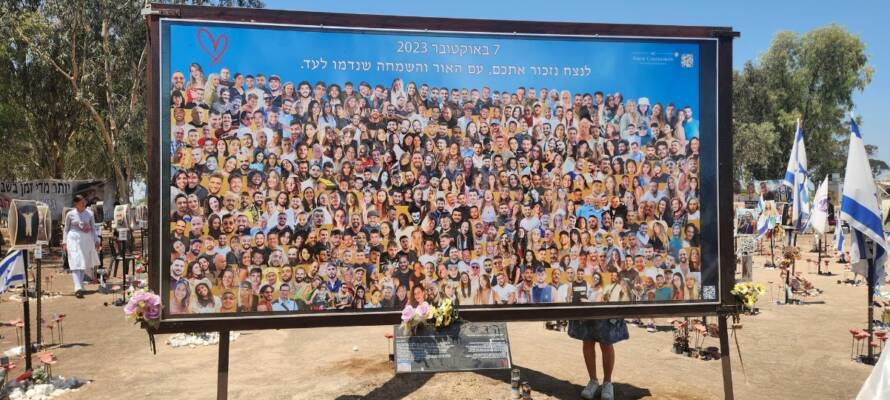‘I hope this helps people feel more empathy for Israel and see another perspective,’ said student Yoav Badash.
By Pesach Benson, TPS
Israeli student Yoav Badash is on a mission to educate his American peers about Hamas’s October 7 massacre at the Nova music festival.
Determined to raise awareness among the 60,000 students at the University of Florida, the 22-year-old economics undergraduate organized a one-day exhibit in the main plaza of the Gainesville campus to tell the story of the massacre.
“When I woke up on the morning of October 7, I went to Instagram and saw friends posting notices about their friends who were missing at the massacre,” Badash told The Press Service of Israel. “It saddened me that so many people in the U.S. didn’t even know what happened.”
The all-night music festival, attended by 3,500 people on the grounds of Kibbutz Re’im, became a killing field where 364 people were massacred and 40 others were taken hostage. Of all the locations attacked by Hamas on October 7, the highest death toll was at the music festival.
The exhibit began with images capturing the festival’s vibrant atmosphere and transitioned to scenes of chaos as gunfire and rockets erupted. It concluded with facts about the massacre and a small memorial to honor the victims.
“I wanted people to relate,” he explained. “Between the photos, I included flags representing the nationalities of those murdered or kidnapped because this wasn’t just an Israeli tragedy—it affected people from all over the world.”
The event sparked mixed reactions. “Some people screamed at us, accusing us of supporting genocide, which was so hypocritical,” he said.
“But a lot of students showed support. They told me how horrific the massacre was and how they were moved by the exhibit.”
Many visitors returned for a second look, took videos, and asked questions. “It was very emotional,” Badash added.
Badash believes the event made an impact. “Changing opinions doesn’t happen overnight, but when Jewish organizations keep telling the story of October 7 through multiple events, it starts to sink in,” he said.
“I hope this helps people feel more empathy for Israel and see another perspective.” Gathering materials for the exhibit and booking the plaza required collaboration and perseverance.
“Shaye Klein, a photographer, helped me get some photos, and Tribe of Nova, the festival’s organizers, provided others,” Badash said. “I also met Ron El-Hai, a Nova survivor, here in Gainesville. He gave me more photos and helped create the text for the memorial.”
The local Hillel, Students Supporting Israel and Tikva student groups also collaborated on the event. Badash, who is originally from Rishon LeZion, said his activism is shaped by his experience at the University of Tampa.
“One morning, I woke up to messages about ‘Free Palestine’ graffiti all over campus. Some said, ‘From the river to the sea, Palestine will be free,’” he recalled.
“As the only Israeli student there, I felt very unsafe.” He considered transferring to Columbia, Cornell, or the University of Michigan, “but friends sent me messages about those universities being unfriendly to Jews.”
In contrast, he feels at home at the Florida campus, where Jews make up about 25% of the student population. “I feel safe going to Jewish events and wearing a hamsa here,” he said, referring to an amulet in the shape of an open hand that is popular in Jewish culture.
“There are places in the U.S., like New York, where I wouldn’t feel safe doing that.”
Looking ahead, Badash is planning another event for next semester. “This time, I want to show a side of Israel that people don’t often see—its culture, innovation, and beauty,” he said.
“People told me booking the plaza and organizing the exhibit would be too difficult, but I proved them wrong,” he said. “It gives me confidence to keep going and to do even more.”
